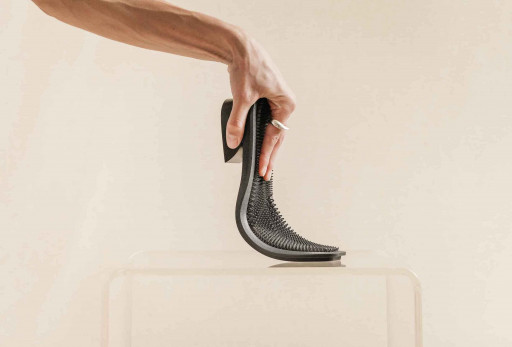
The Aurora platform
Creating a radically new and flexible way to make shoes
PORTLAND, Ore. - March 9, 2022 - (Newswire.com)
Today, HILOS is releasing the first environmental evaluation of 3D printed shoes. By working with a team at Yale University, BASF, and AMT, HILOS assessed its 3D-printed shoemaking technology as an alternative to traditional industrial shoemaking.
Headline findings showed a 48% reduction in carbon and a 99% reduction in water usage compared to legacy manufacturing, saving nearly 2,000 gallons of water and over 20 lbs of CO2e per pair.
As the fashion industry struggles to meet its commitments to net-zero by 2030, this case study provides practical technologies that can be adopted to immediately lighten the industry's footprint.
Is circularity enough?
Before the study, HILOS predicted that product recycling across its reverse supply chain would have a major impact on overall emissions. While circularity reduced carbon emissions by 7.25%, this was assuming a 100% product return rate. The actual impact would likely be much less.
This is largely because of the energy required to reprocess material for a second life. If those recycling processes had been carbon-neutral, product circularity could reduce carbon emissions (in HILOS' case) by up to 22%.
The conclusion? Increasing the efficiency of material renewal is key to leveraging the full potential of product circularity.
What mattered most?
Product design had far and away the greatest impact on material waste. A typical shoe can be made up of 65 discrete parts assembled in 360 steps. By contrast, HILOS' Emmett line is made from five parts assembled in 12 steps.
Altogether, part and material reduction accounted for a 29% drop in carbon emissions. That combined with on-demand production, or only making products that would actually be sold, had the most dramatic impact on carbon reduction, jointly reducing carbon by 43%. The key takeaway: the right design and application of 3D printing are critical for overall carbon reduction.
Putting it all together
This means circularity is only one part of the equation. Even if everything we made today was 100% returned and recycled, manufacturing is still a wasteful and resource-intensive process. Brands overproduce. In apparel, this sometimes means making as much as 35% more than is needed. The industry can avoid creating and recycling shoes no one needs by only crafting on-demand after a customer makes a purchase.
Access the full case study here.
Press Release Service by Newswire.com
Original Source: HILOS Releases First Environmental Evaluation of 3D-Printed Footwear













